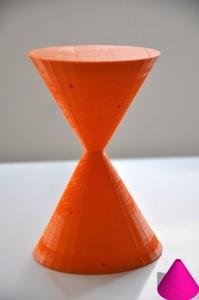 Giving high-school students access to 3D design and printing equipment seems to have a profound, positive effect on learning and communication, according to a pilot study in Greece.
Giving high-school students access to 3D design and printing equipment seems to have a profound, positive effect on learning and communication, according to a pilot study in Greece.
The project ties in with a theory called constructionist learning – first put forward by eminent mathematician and computer scientist Seymour Papert – which suggests people learn things most effectively when they construct mental models to understand the world around them.
Taking the idea a stage further, the researchers provided access to an open-source 3D printer and design platform, allowing students to collaboratively design and create tangible objects in the real word. This could certainly make the approach even more powerful.
“We asked what role could 3D printing and design, along with modern information and communications technology (ICT), play in developing and implementing new educational ideas based on the principles of constructionism,” say the researchers from the Tallinn University of Technology in Estonia.
More than 30 high school students aged 15-16 were given a crash course in 3D designs and printing using the equipment provided, and were then encouraged to create 3D-printed artifacts that were novel, usable and – if desired – could be designed for use by blind children.
“The children were expected to think creatively; experiment; adapt and perform creatively in small-groups, pairs or even individually,” note the researchers.
 All told, 17 artefacts were printed by the students during the ‘project course’ – a two-hour weekly lesson included in the Greek curriculum for research-based projects. In all but three cases the children opted to design the items with blind people in mind. Examples included a 3D comic book, a Braille version of the Sudoku puzzle game, a cup with the message ‘drink me’ inscribed in Braille and a Rubik’s cube with Braille language letters instead of colours.
All told, 17 artefacts were printed by the students during the ‘project course’ – a two-hour weekly lesson included in the Greek curriculum for research-based projects. In all but three cases the children opted to design the items with blind people in mind. Examples included a 3D comic book, a Braille version of the Sudoku puzzle game, a cup with the message ‘drink me’ inscribed in Braille and a Rubik’s cube with Braille language letters instead of colours.
Another group designed and created a variation on an hourglass, which used marbles instead of sand to produce sound and allow a blind user to count the passage of time.
The project helped students “think differently than they did previously and, thus, see the world differently,” write the authors in the journal Telematics and Informatics (article in press).
A teacher from one of the schools that took part in the project, Loukianos Xaxiris, said the project also helped with issues, such as a lack of engagement by students.
“My class consisted of generally uncooperative, especially concerning the project course, students who – surprisingly enough – were very willing to engage in this particular project,” he told the researchers.
That sentiment was echoed by a teacher from the second school, Christos Bitsis, who said: ” this change is a result of children’s increased connection with the world … followed by an increase in their self-esteem.”
While the experiment was a success, the researchers did uncover one problem. It was great that two schools were happy to embrace the initiative, but the directors of several others “seemed unable to comprehend our goals and [were] unwilling to cooperate.”
The team now calls for more research in this area making use, not only of open-source 3D printing, but also other open source hardware such as Arduino microcontrollers.
We may be on the cusp of radical changes within our education systems around the world. 3D printing promises to play a major role. Let us know your thoughts on this story and others related to 3D printing in education, in the 3D printing for education forum on 3DPB.com.
Subscribe to Our Email Newsletter
Stay up-to-date on all the latest news from the 3D printing industry and receive information and offers from third party vendors.
You May Also Like
3D Printing Unpeeled: New Arkema Material for HP, Saddle and Macro MEMS
A new Arkema material for MJF is said to reduce costs per part by up to 25% and have an 85% reusability ratio. HP 3D HR PA 12 S has been...
3D Printing News Briefs, January 20, 2024: FDM, LPBF, Underwater 3D Printer, Racing, & More
We’re starting off with a process certification in today’s 3D Printing News Briefs, and then moving on to research about solute trapping, laser powder bed fusion, and then moving on...
3D Printing Webinar and Event Roundup: December 3, 2023
We’ve got plenty of events and webinars coming up for you this week! Quickparts is having a Manufacturing Roadshow, America Makes is holding a Member Town Hall, Stratafest makes two...
Formnext 2023 Day Three: Slam Dunk
I’m high—high on trade show. I’ve met numerous new faces and reconnected with old friends, creating an absolutely wonderful atmosphere. The excitement is palpable over several emerging developments. The high...
































